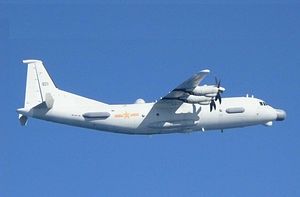The Japan Air Self-Defense Force (JASDF) scrambled fighter jets to intercept a People’s Liberation Army Navy Air Force (PLANAF) Shaanxi Y-9JB (GX-8) electronic warfare and surveillance plane crossing the Sea of Japan and East China Sea on October 29, Japan’s Ministry of Defense (MOD) reported earlier this week.
This marks the fourth time that Japan dispatched fighter jet to intercept and escort a PLANAF Y-9JB spy plane in recent months. The last intercept occurred on August 29. A previous Y-9jB intercept took place on July 27. In both cases the PLANAF aircraft was intercepted while traversing Sea of Japan and East China Sea. Furthermore, a Y-9JB flying through international airspace between the Japanese islands of Okinawa and Miyako was intercepted in June.
In neither of the four Chinese spying missions did the PLANAF Y-9JB aircraft, an upgraded variant of the first-generation Y-8DZ and Y-8G electronic reconnaissance planes, violate Japanese airspace, according to the MoD. As I reported previously, although the MOD usually does not reveal the aircraft type, intercepts are normally conducted by two JASDF aircraft types:
The JASDF usually dispatches Mitsubishi F-15J all-weather air superiority fighters, 215 of which — including the upgraded F-15DJ/F-15J Kai variants — are currently operationally deployed with the service.
The JASDF’s other workhorse for interceptor missions is the F-2 multirole fighter jet, a Mitsubishi license-produced variant of Lockheed Martin’s F-16, of which there are currently around 90 officially in service.
In 2016, the JASDF has doubled the number of fighter jets dispatched for each intercept of foreign military aircraft approaching Japanese airspace from two to four.
The number of scrambles made by the JASDF against Chinese military aircraft is increased by about 20 percent during the first six months of this fiscal year. Up until September 2018, 345 Chinese intercepts have been recorded by the JASDF. This is an increase of 58 sorties, in comparison to the previous fiscal year. As I reported in April, the number of JASDF scrambles decreased by 23 percent in fiscal year 2017 in comparison to 2016:
Overall, the JASDF scrambled fighter jets 904 times in response to unidentified aircraft approaching Japanese airspace during the last fiscal year that ended in March.
Out of the total of 904, 500 scrambles occurred in response to People’s Liberation Army Air Force (PLAAF) aircraft and 390 were prompted by Russian military planes.
This constitutes a decline of 41 percent for PLAAF aircraft, but a 29 percent increase of intercepts of Russian planes. Chinese and Russian aircraft respectively accounted for 55 percent and 43 percent of total intercepts in fiscal year 2017.
The last intercept of Russian military aircraft (two Ilyushin Il-20 maritime reconnaissance and anti-submarine warfare planes) took place on October 19. The JASDF previously had to scramble fighter jets on September 20. On its October 29 mission, the Y-9B also entered South Korea’s air defense identification zone (KADIZ), according to South Korean media reports. Air defense identification zones are not considered sovereign or territorial airspace and sections of the KADIZ overlap with air defense identification zones designated by China and Japan.

































